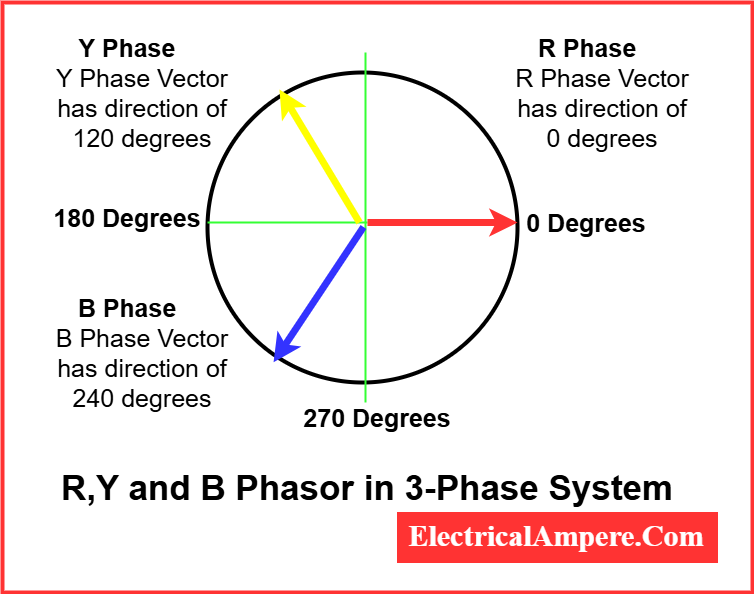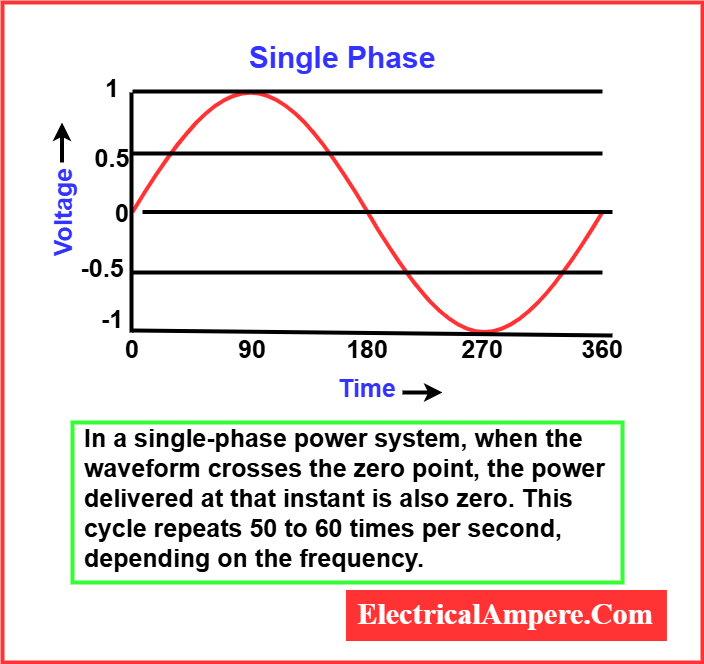Learn why three-phase voltage in India is 440 volts. Understand 440 voltage, phase to phase voltage, and the difference between single and three-phase supply.
In India and many other countries, the standard three-phase voltage is commonly known as 440 volts. But have you ever wondered why this specific value is used in electrical systems? Why not 500 volts or 400 volts? Let’s explore the science, reasoning, and standards behind the widely accepted 440 voltage in a three-phase system.
Understanding Three-phase Voltage
Before we dive into the 440 volts value, let’s understand what three-phase voltage means.

A three-phase supply is an AC power system that uses three alternating currents, each set 120 degrees apart. It’s the most efficient method of transmitting electrical power, especially in industrial and commercial environments.

In a three-phase system, there are two types of voltages:
- Phase Voltage (Line to Neutral)
- Line Voltage (Phase to Phase)
What is Phase Voltage?
Phase voltage is the voltage measured from any one phase to the neutral point. In India, the standard single-phase voltage or phase voltage is 230 volts.

So when we talk about three-phase voltage , we refer to the line-to-line voltage, which is approximately 440 volts.
The Math Behind 440 Volts
In a balanced three-phase system:

Substituting the standard phase voltage in India:

But to standardize and simplify, it’s rounded to 400V or 415V in many countries. However, 440 volt became popular in India and some regions due to historical practices, older equipment ratings, and a slight voltage boost provided by power systems to accommodate voltage drops across transmission.
Thus, the common reference remains as 440 voltage or 440 volts for three-phase systems in India.
Why is 440V Used for Three-Phase Systems?
Many people assume that if a single-phase voltage is 230V, then three-phase voltage should be simply:
230V + 230V + 230V = 690V
However, this is incorrect. In a three-phase power system, voltages are not added linearly because they are vector quantities (phasors) with both magnitude and direction.
Each phase in a three-phase system is separated by a 120° phase angle, and all three phases continuously vary in time. When we calculate the voltage between any two phases (called line voltage), we must consider the vector difference, not a simple arithmetic sum.
If each phase has 230V (which is the phase voltage in India), the voltage between any two phases (line-to-line) is approximately 400V, not 690V. This result comes from vector analysis using the cosine rule:

Substituting 230V:

since,
cos(1200)= -0.5

So, in a three-phase system with 230V per phase, the line-to-line voltage becomes about 400V, not 690V.
Then why is 440V often referenced?
In India and many other regions, the nominal line voltage is standardized at 440V, allowing for voltage drops and tolerance limits. So while the theoretical line voltage is 400V, the supply is rated slightly higher (440V) for practical and regulatory reasons.
Why 440V in Three Phases Instead of 660V or 690V?
If we analyze the sinusoidal waveforms of a three-phase power system, we notice that each phase is 120° apart. At any given moment, only two of the three phases are in a positive cycle, while the third is in a negative cycle. This is due to the continuous phase shift and alternating nature of the current.
So, at any point in time, only two phases contribute positively, such as:
- Phase 1 & Phase 2
- Phase 2 & Phase 3
- Phase 3 & Phase 1
The third phase at that moment is negative.
This interaction between any two active phases results in a line voltage of approximately 440V, not 660V or 690V. The reason it isn’t a direct addition (230V + 230V = 460V or more) is because of the vector (phasor) nature of alternating current. The voltages are 120° apart, so we must use vector (not arithmetic) addition.
Using vector math:

However, in industrial practice in India, the standard three-phase voltage is rounded to 440V to allow for losses, tolerance, and equipment design.
If a Single-Phase Circuit is 230V, Why is a Three-Phase Circuit 440V and Not 690V?
This is a common question, and the answer lies in how voltages are measured and added in AC systems:
1. Understanding Voltage
- Voltage is the potential difference between two points.
- In a single-phase system, this is the difference between phase and neutral—typically 230V in India.
2. Three-Phase Voltage Basics
- In a three-phase system, all three wires (phases) have the same RMS voltage with respect to neutral (230V).
- However, when measuring between two phases (called line voltage), the voltage is higher due to their 120° phase shift.
3. Why Not 690V (230V × 3)?
- You cannot simply add 230V + 230V + 230V to get 690V.
- This is because AC voltages are vector quantities (phasors), not scalar values.
- The correct way to calculate the line voltage is using this formula:

This is often rounded to 400V or standardized as 440V in practice (especially in India), considering real-world factors like losses and voltage drops.
4. Visualizing It
- Imagine one phase is at its maximum positive peak (+220V), while another is at its maximum negative peak (-220V).
- The potential difference between them is:
(+220V)−(−220V)=440V
This is the maximum instantaneous voltage between any two phases.
5. Summary
- Each phase = 230V (RMS) with respect to neutral.
- Voltage between any two phases (line voltage) = 440V, not 690V.
- The 440V comes from vector addition due to the 120° phase shift between the three waves.
Why 440 Volt Became the Standard?
Several reasons explain the widespread use of 440 volts:
1. Historical Equipment Ratings
Older motors, machinery, and industrial tools were designed to operate around 440V. Standardizing the supply helped ensure compatibility.
2. Voltage Drop Compensation
Power companies often supply slightly higher voltages (like 440V) at the source to ensure that even after voltage drops over long distances, the equipment still gets close to its required operating voltage.
3. Efficiency in Power Distribution
Higher 3 phase voltage like 440V ensures better efficiency in power transmission and reduces losses compared to lower voltages.
Three Phase Voltage in India
In India, the typical 3 phase voltage ratings are:
- Phase to Neutral (Single-phase voltage) = 230 volts
- Phase to Phase (Line Voltage) = 440 volts
So the 3 phase supply voltage in India is commonly referred to as 440V even though the theoretical value is closer to 398V or 415V.
What About 2 Phase Voltage?
Technically, there is no such thing as a true 2 phase voltage in modern power systems. Sometimes, two phases of a 3-phase system are used together (for instance, for certain motor controls or equipment), but it’s not a distinct supply type. It’s still derived from a 3 phase system.
Is Phase to Phase Voltage Always 440 Volts?
Not always. The phase to phase voltage in 3 phase systems can vary depending on:
- Country and its electrical standards
- Transformer ratings
- Distance from power source
- Industrial or residential application
In many regions, it’s 400V, 415V, or even 480V. But in India, 440 volt is a commonly accepted and used term.
Key Differences: Single-phase vs Three-phase
Difference Between Single-Phase and Three-Phase
| S.NO | SINGLE-PHASE | THREE-PHASE |
|---|---|---|
| 1 | Electricity flows through a single conductor in a single-phase connection. | A three-phase connection requires three conductors for electrical transmission. |
| 2 | The voltage of a single-phase power supply system is typically 230 Volts. | A three-phase system can carry voltages of up to 440 Volts. |
| 3 | Single-phase requires two wires: one neutral and one phase wire. | A three-phase system requires one neutral wire and three phase wires. |
| 4 | In a single-phase system, if one wire fails, the entire power supply is interrupted. | In a three-phase system, if one phase fails, the remaining phases continue to supply power without interruption. |
| 5 | Ideal for light loads such as lighting and heating. | Suitable for powering large industrial motors and heavy machinery. |
| 6 | Power distribution in a single-phase system is inconsistent, with voltage peaks and dips. | Power delivery in a three-phase system is stable and consistent due to the 120° phase difference between the conductors. |
| 7 | Losses in single-phase operation are high. | Three-phase circuits have lower losses, making them more efficient. |
| 8 | Single-phase systems have a lower level of efficiency. | Three-phase systems provide maximum efficiency in power distribution. |
| 9 | Single-phase systems are generally less expensive than three-phase systems. | Three-phase systems are more expensive to install but offer greater benefits. |
| 10 | Single-phase systems can transfer only a limited amount of power. | Three-phase systems can transfer a higher amount of power, making them ideal for industrial use. |
Difference Between 415V and 440V
| S.NO | 415V | 440V |
|---|---|---|
| 1 | The RMS (Root Mean Square) voltage from line to line is 415V. | The maximum peak voltage is 440V. |
| 2 | The transformer operates at or around 415V when fully loaded, and it allows control of supply variations using transformer tappings. | To compensate for internal resistance in the transformer, the nominal voltage is 440V. At full load, a transformer with 5% impedance will experience a 5% voltage drop. |
| 3 | 415V is commonly used for industrial and commercial three-phase systems. | 440V is typically used in regions where voltage supply standards are higher for industrial equipment. |
| 4 | 415V is the nominal voltage for three-phase systems in many countries, such as the UK and India. | 440V is more commonly used in the US and some other parts of the world for heavy-duty machinery. |
| 5 | 415V systems tend to have lower current draw compared to 440V systems. | 440V systems may result in higher current being drawn when the same power is supplied due to the higher voltage level. |
| 6 | Voltage fluctuations are more noticeable at 415V due to variations in transformer loading. | The 440V system is more robust against fluctuations and tends to provide a more stable voltage under varying load conditions. |
FAQs
Q1: What is the 3 phase voltage in India?
Ans: The standard 3 phase voltage in India is approximately 440 volts (line-to-line) and 230 volts (line-to-neutral).
Q2: Why is the voltage 440 in 3-phase systems?
Ans: Due to the formula involving √3 times the phase voltage (230V) and practical factors like voltage drop compensation, the value is standardized and rounded to 440 volts.
Q3: Is 440 volts the same as 440 volt current?
Ans: No. Voltage is the potential difference, while current (amperes) measures the flow of electricity. 440 volt current refers to current flowing in a system supplied with 440V.
Conclusion
The use of 440 voltage in three-phase systems in India is a result of both standard calculation and historical electrical practices. While the theoretical value might be slightly different, the practical and widely used figure is 440 volts. Understanding this helps you select the right equipment, calculate loads accurately, and ensure safe power distribution — especially in industrial and commercial settings.
Whether you’re dealing with 3 phase voltage in India, 440 volt current, or wondering what is phase voltage, knowing these concepts is key to effective electrical planning.
Read Next: